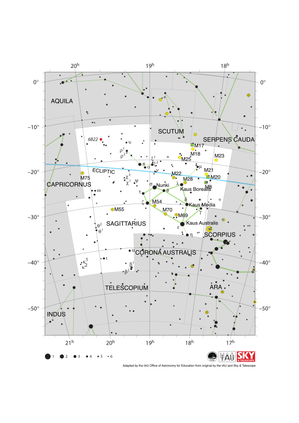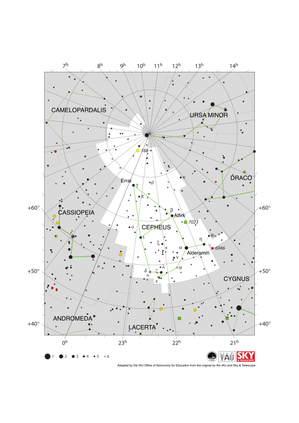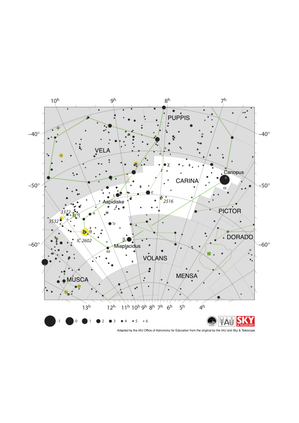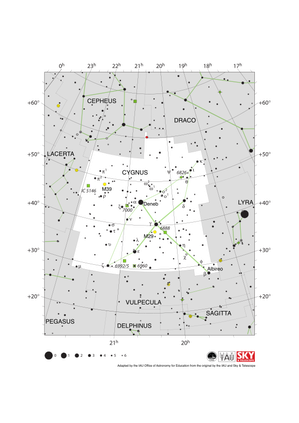Glossary term: Nébuleuse
Description: Une nébuleuse est un objet céleste lointain qui a l'apparence d'un nuage. En général, une nébuleuse est constituée de gaz et de poussières interstellaires. Historiquement, le terme "nébuleuse" englobait tout objet flou étendu, y compris ce que nous appelons aujourd'hui des galaxies, c'est-à-dire des systèmes stellaires lointains comme notre propre galaxie, la Voie lactée. Aujourd'hui, le terme "nébuleuse" se limite aux nuages de gaz et de poussière qui font partie du milieu interstellaire, c'est-à-dire le gaz et la poussière qui se trouvent entre les étoiles d'une galaxie. Cette catégorie comprend différents types d'objets :
Les nuages moléculaires sont relativement froids et sombres, et se composent principalement d'hydrogène moléculaire ; c'est à l'intérieur de ces nuages que se forment les nouvelles étoiles. Les nuages moléculaires géants peuvent contenir jusqu'à quelques millions de masses solaires de gaz d'hydrogène. Les jeunes étoiles émettent souvent des jets étroits de gaz ionisé ; lorsque ces jets excitent le gaz environnant, il en résulte un type de nébuleuse appelé objet de Herbig-Haro. Lorsque des étoiles massives se sont formées, leur rayonnement intense fait que le gaz environnant émet une lumière rougeâtre caractéristique ; il en résulte des nébuleuses de gaz d'hydrogène chaud et ionisé appelées régions HII. D'autres types de nébuleuses sont associés à la mort des étoiles : les étoiles de faible masse laissent derrière elles des coquilles de gaz en expansion que l'on appelle (de façon un peu confuse) nébuleuses planétaires. Lorsqu'une étoile de masse élevée explose en supernova, le gaz éjecté forme un type de nébuleuse appelé vestige de supernova.
Related Terms:
See this term in other languages
Term and definition status: The original definition of this term in English have been approved by a research astronomer and a teacher The translation of this term and its definition is still awaiting approval
The OAE Multilingual Glossary is a project of the IAU Office of Astronomy for Education (OAE) in collaboration with the IAU Office of Astronomy Outreach (OAO). The terms and definitions were chosen, written and reviewed by a collective effort from the OAE, the OAE Centers and Nodes, the OAE National Astronomy Education Coordinators (NAECs) and other volunteers. You can find a full list of credits here. All glossary terms and their definitions are released under a Creative Commons CC BY-4.0 license and should be credited to "IAU OAE".
If you notice a factual or translation error in this glossary term or definition then please get in touch.
Related Diagrams
Sagittarius Constellation Map
Credit: Adapted by the IAU Office of Astronomy for Education from the original by IAU/Sky & Telescope
License: CC-BY-4.0 Creative Commons Attribution 4.0 International (CC BY 4.0) icons
Auriga Constellation Map
Credit: Adapted by the IAU Office of Astronomy for Education from the original by the IAU and Sky & Telescope
License: CC-BY-4.0 Creative Commons Attribution 4.0 International (CC BY 4.0) icons
Cepheus Constellation Map
Credit: Adapted by the IAU Office of Astronomy for Education from the original by the IAU and Sky & Telescope
License: CC-BY-4.0 Creative Commons Attribution 4.0 International (CC BY 4.0) icons
Carina Constellation Map
Credit: Adapted by the IAU Office of Astronomy for Education from the original by the IAU and Sky & Telescope
License: CC-BY-4.0 Creative Commons Attribution 4.0 International (CC BY 4.0) icons
Cygnus Constellation Map
Credit: Adapted by the IAU Office of Astronomy for Education from the original by the IAU and Sky & Telescope
License: CC-BY-4.0 Creative Commons Attribution 4.0 International (CC BY 4.0) icons
Related Activities
Reading the Rainbow
astroEDU educational activity (links to astroEDU website) Description: By understanding how rainbows work, you can discover about light and its properties, learning about stars, nebulae, galaxies, and our Universe.
License: CC-BY-4.0 Creative Commons Attribution 4.0 International (CC BY 4.0) icons
Age Ranges:
14-16
, 16-19
, 19+
Education Level:
Informal
, Middle School
, Secondary
, University
Areas of Learning:
Interactive Lecture
, Observation based
, Social Research
Costs:
Low Cost
Duration:
1 hour 30 mins
Group Size:
Group
Skills:
Analysing and interpreting data
, Asking questions
, Engaging in argument from evidence














